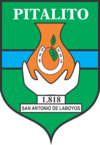Pitalito
| Pitalito Guacacayo (River of the tombs) | |||
|---|---|---|---|
| Municipality and town | |||
| |||
| Nickname(s): Valle de Laboyos | |||
| Motto: "A better town, a municipality for everybody" | |||
 Location of the municipality and town of Pitalito in the Huila Department of Colombia. | |||
 Pitalito Location in Colombia | |||
| Coordinates: CO 01°52′N 76°02′W / 1.867°N 76.033°W | |||
| Country |
| ||
| Department | Huila Department | ||
| Founded | June 13, 1818 | ||
| Government | |||
| • Mayor | Pedro Martin Silva | ||
| Elevation | 1,318 m (4,324 ft) | ||
| Population (2012) | |||
| • Municipality and town | 118,677[1] | ||
| • Metro | 69,395[1] | ||
| Demonym(s) | Laboyano | ||
| Time zone | Colombia Standard Time (UTC-5) | ||
| Area code(s) | 57 + 8 | ||
| Website | Official website (Spanish) | ||
Pitalito is a Colombian town and municipality located to the south of the Department of Huila, Colombia over the Valley of the Rio Grande de la Magdalena, 180 km from its capital Neiva. It is referred as "The Valley of Laboyos". It is also the second most populated municipality in the Department of Huila, with approximately 150 000 inhabitants, and is considered the largest producer of coffee in Colombia, in whose land are cultivated coffee beans of very high quality, therefore has become the new Coffee-growing region of Colombia, being epicenter of production the District of Brussels. On several occasions it has been awarded with the "Cup of Excellence", for being the best coffee in the country. [2]
History
Foundation date: June 13, 1818
Name of the founder: José Hilario Sierra
ORIGINS AND FOUNDATION OF PITALITO
José Hilario Sierra, priest and doctor, was appointed priest of the vice-parish of "Los Laboyos' in the year of 1818. This year, some of the residents of the vice-parish decided to build their houses on the site they called Pitalito, located two miles northeast of the Laboyos, a picturesque region, attracted by the fertility of the soil, the mild climate and the abundance of water, as well as construction materials. Others and others followed those in the same year, resulting in the depopulation of the village of Laboyos in a very short time, because almost all of its inhabitants moved to populate the region of Pitalito in the Cálamo estate, and contiguous to Solarte estate, where there were already more than two thousand cattle and horses.
The progressive doctor Sierra, seeing that his parishioners were dispersed, decided, under his Ministry, follow them, as good shepherd who was, and he had to move to the newly populated place, where he built a hut little chapel to administer the Holy sacraments and celebrate mass. This Chapel, the first in that place, was located where today stands the Temple of San Antonio; in front of the chapel, doctor Sierra demarcated the square and the streets of the new town, which took place in the year 1819.
After three years and having increased considerably the neighborhood, the new village requires a mayor, being appointed to that post Don Jorge de Cuéllar, son of Don Luis de Cuéllar, someone important in the town of Timaná, one of the owners of the region and person of noble lineage, son of Don Jerónimo de Cuéllar originating in the kingdoms of Spain in Andalusia's rich as well as his son Luis Cristobal. [3]
References
- 1 2 [http://pitalito-huila.gov.co/sitio.shtml?apc=myxx-1-&x=2760314&als[ESTADO__]=myxx-1-#poblacion Población]. pitalito-huila.gov.co
- ↑ Translated from Wikipedia en español
- ↑ Translated from http://pitalito-huila.gov.co/informacion_general.shtml#historia
External links
Coordinates: 1°53′56.09″N 76°02′30.73″W / 1.8989139°N 76.0418694°W
.svg.png)
